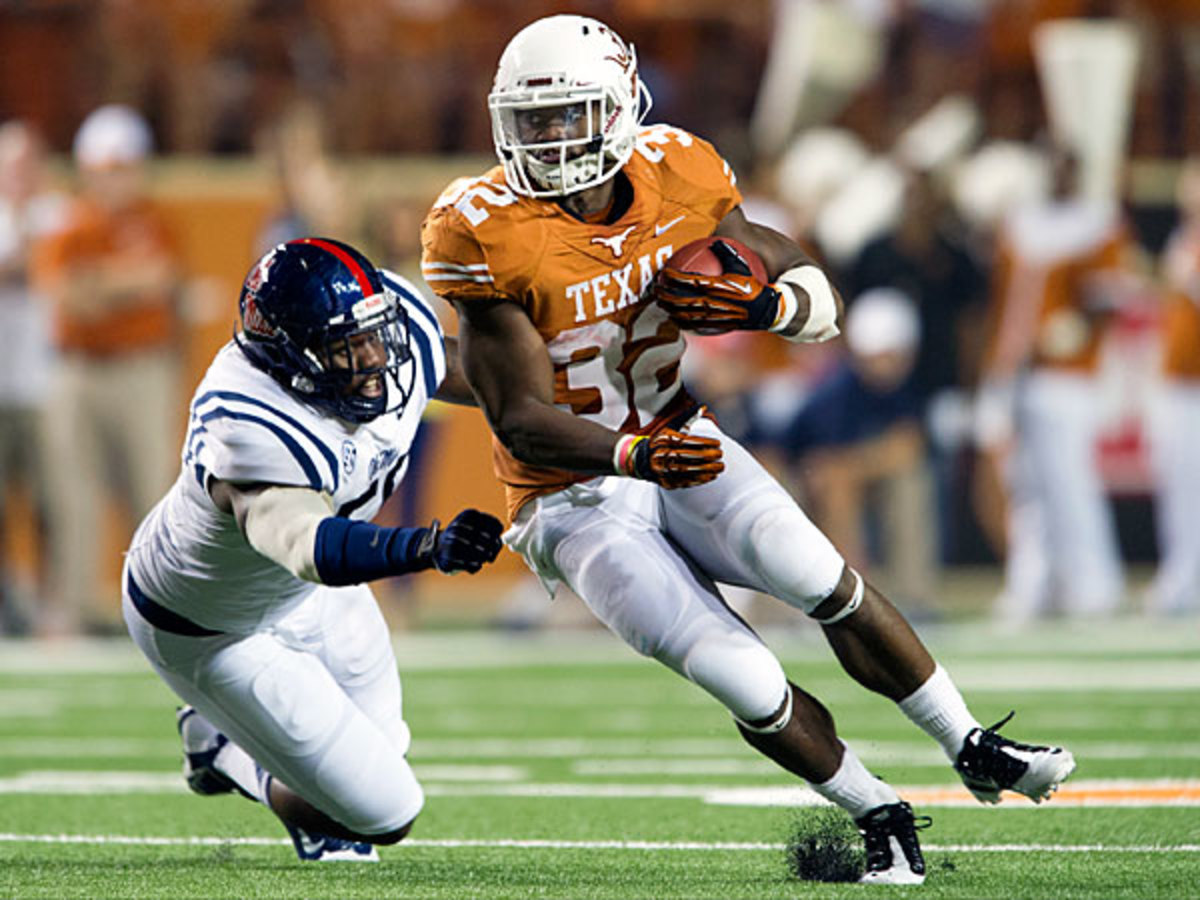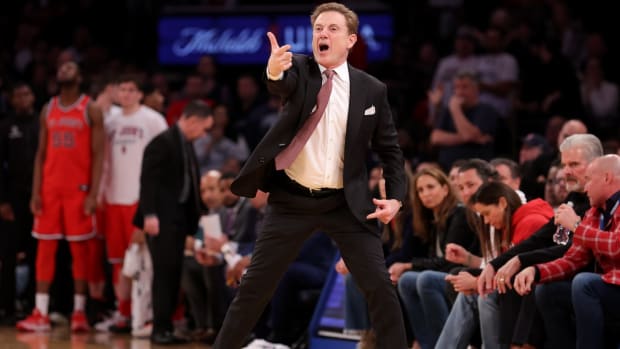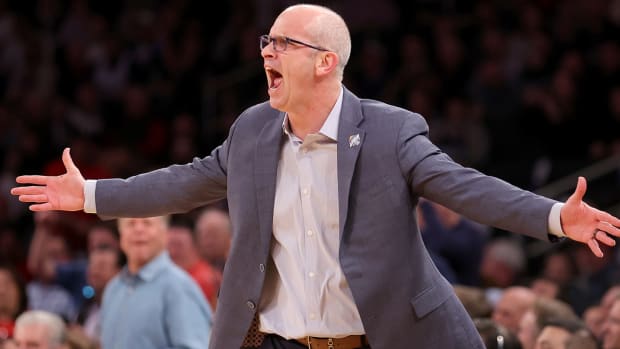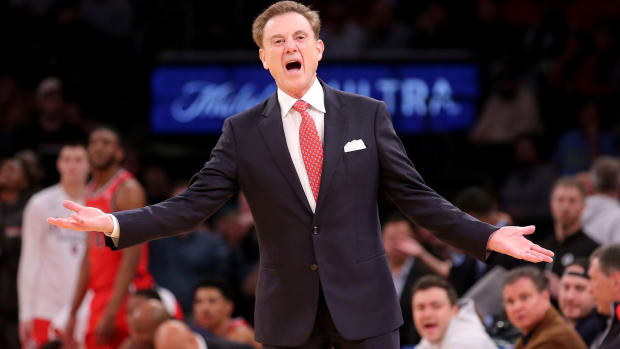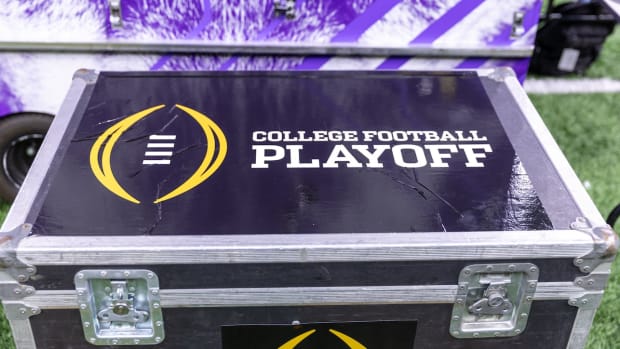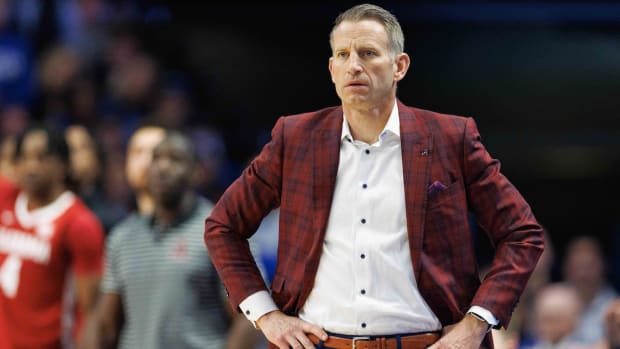Burning questions for each of the major conferences at the end of 2014 spring practice
Can Johnathan Gray (32) and Texas compete for a Big 12 title under Charlie Strong? (Cooper Neill/Getty Images)
Most of the big stories in college football this spring happened off the field. The reigning Heisman Trophy winner was cited for shoplifting crab legs and crawfish from a grocery store. A group of Northwestern players voted whether to form a union. The College Football Playoff unveiled a set of criteria for its selection committee, formalized a recusal policy and announced it would release weekly rankings during the second half of the season.
What happened on the field? A few notable storylines emerged. However, rather than review them all, let’s look ahead to the upcoming season by focusing on one major question facing each of the five power conferences.
Post-spring Power Rankings l Heisman Watch
ACC: Who will be Florida State’s biggest challenger?
Fresh off its first national title in 14 years, Florida State enters 2014 as the clear ACC favorite. Although its defense loses several key contributors, including tackle Timmy Jernigan and cornerback Lamarcus Joyner, any team that returns a reigning Heisman winner at quarterback should feel good about its chances. Beyond Jameis Winston, another reason to hop on the Seminoles' bandwagon is their ACC competition. Florida State appears head and shoulders above the rest of the league. So, who could give the 'Noles the most trouble?
Clemson’s list of offseason departures is daunting. Still, there’s cause to believe that coach Dabo Swinney’s team shouldn’t slip too much after beating Ohio State in the Orange Bowl. While replacing quarterback Tajh Boyd and receivers Sammy Watkins and Martavis Bryant won’t be easy, a proven offensive system -- and the esteemed, well-compensated coordinator who has orchestrated it the past two seasons -- isn’t going anywhere. Clemson’s defense should also be vastly improved with seniors Vic Beasley and Corey Crawford anchoring a deep line.
In the end, Florida State’s biggest challenge may be its schedule: The Seminoles face nonconference tests against Oklahoma State (Aug. 30) and Notre Dame (Oct. 18), as well as road games at Louisville (Oct. 30) and Miami (Nov. 15). And don't sleep on North Carolina. The Tar Heels won six of their final seven games last fall and return quarterback Marquise Williams and all-purpose dynamo Ryan Switzer, among others.
STAPLES: Joking aside, Jameis Winston's shoplifting raises legitimate concerns
Big Ten: Will the league continue to make progress?
The Big Ten has caught plenty of flak in recent seasons for its lumbering pace and low-scoring games. For college football fans, #B1G memes have become a staple of Saturday afternoons. It hasn’t helped that the league has also struggled in high-profile nonconference games and in the postseason. Entering 2014, however, there are reasons to be optimistic.
Wisconsin (Melvin Gordon and Corey Clement) and Nebraska (Ameer Abdullah and Imani Cross) return talent at running back. Ohio State brings back a Heisman candidate (Braxton Miller) and a formidable defensive line. While Michigan State loses key pieces on defense, its offense shouldn’t miss a beat: Rose Bowl-winning quarterback Connor Cook and a capable group of playmakers will look to keep Sparty climbing.
Some of the teams that struggled last season are poised to make strides this fall, too. Northwestern will deploy a solid cast of backs and receivers alongside veteran signal-caller Trevor Siemian. Iowa welcomes back 14 starters and should benefit from a manageable schedule. And Maryland and Rutgers will make their Big Ten conference debuts. Despite its recent shortcomings, the league appears headed in the right direction at the onset of the College Football Playoff era.
STAPLES: Connor Cook, Michigan State looks to build on Rose Bowl momentum
Big 12: Is Texas poised for success under Charlie Strong?
Strong has already conceded that he does not believe Texas will participate in the first championship game of the playoff era. The question is, where do his Longhorns stack up in the Big 12?
An early consensus has formed around Oklahoma as the league’s top team heading into 2014; one outlet even pegged the Sooners No. 1 in its preseason rankings. Baylor turns over most of its defense, but returns star quarterback Bryce Petty and, most importantly, the play-calling wizard rumored to be in contention for a higher-profile job in the same state. The league’s pecking order after those two teams remains unclear. Kansas State could be primed for a bounce-back year, and it would be unwise to overlook Oklahoma State.
If Strong meshes with his new team, though, Texas could make a push. Remember, the 'Horns went 8-5 in 2013 despite dealing with uncertainty at quarterback and the rumors circling Mack Brown. They return a strong trio of running backs and a powerful defensive line. Strong already seems to have initiated a culture change and there should be plenty of optimism around Austin heading into the fall. However, a tough schedule could limit Texas’ win total.
MANDEL: Trevor Knight brings high expectations to Oklahoma; more Mailbag
Pac-12: Who will emerge from a talented group of QBs?
The wealth of quarterback talent around the Pac-12 should ensure its potent offenses keep thriving. The headliners are UCLA's Brett Hundley and Oregon's Marcus Mariota. Both figure to put their teams in contention for a conference (and possibly national) championship, to say nothing of their statuses as projected first-round NFL draft picks.
The rest of the league isn’t short on quality passers, either. Kevin Hogan returns to lead a Stanford offense that must replace four offensive line starters and a workhorse tailback. Taylor Kelly will pilot an Arizona State attack that could rank among the Pac-12’s best. And Sean Mannion, who ranked second nationally in passing yards per game last season, will keep pushing at Oregon State without Biletnikoff Award-winning receiver Brandin Cooks. All told, 10 of the league's starting quarterbacks are back (Hogan, Hundley, Kelly, Mannion, Mariota, Cal's Jared Goff, Utah's Travis Wilson, Colorado's Sefo Liufau, Washington State's Connor Halliday and USC's Cody Kessler).
The fact that four of last year’s top five rushers (Arizona's Ka’Deem Carey, Washington's Bishop Sankey, Stanford's Tyler Gaffney and Arizona State's Marion Grice) departed in the offseason only increases the likelihood that teams will air it out.
STAPLES: After deciding to return, UCLA's Brett Hundley coming into his own
SEC: Will tailbacks take control of the conference?
Watching SEC football last season was a bit disorienting. The league known as the gold standard for “grown-man football” was defined by elite quarterback play. Yet there's a strong chance a ground-and-pound mentality could become prevalent again this fall.
Seven of the league’s top passers from last year -- LSU's Zach Mettenberger, Texas A&M's Johnny Manziel, Alabama's AJ McCarron, Georgia's Aaron Murray, South Carolina's Connor Shaw, Vanderbilt's Austyn Carta-Samuels and Missouri's James Franklin -- are gone. What the league lacks in quarterback star power, however, it makes up for in running back depth. The SEC loses its two leading rushers from 2013 (Tre Mason and Jeremy Hill), but SEC backfields remain dangerous.
Among the backs to watch: Alabama's T.J. Yeldon and Derrick Henry, Georgia's Todd Gurley, South Carolina's Mike Davis and LSU's Leonard Fournette. Yeldon and Davis were included in SI.com’s Post-spring Heisman Watch. Still, given the offensive evolution taking college football by storm, don’t expect every game to finish with a score like 14-10. Even with this year’s rushing-oriented personnel, the old-school label may no longer apply to the SEC.
GLICKSMAN: Pride of New Orleans: The youth and promise of Leonard Fournette
